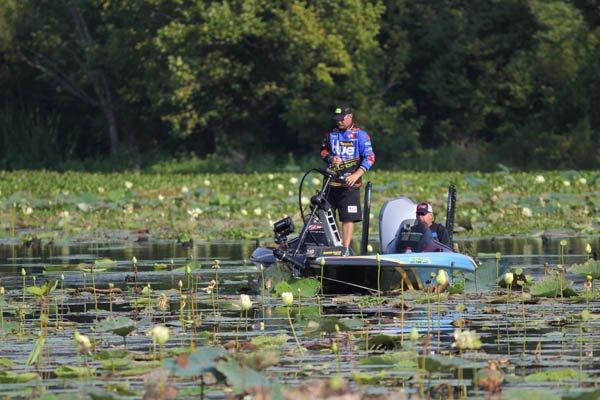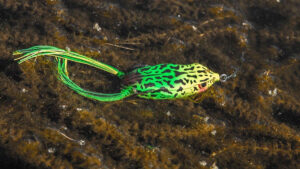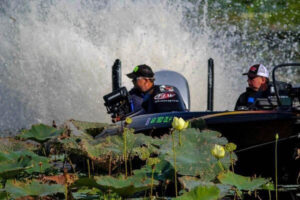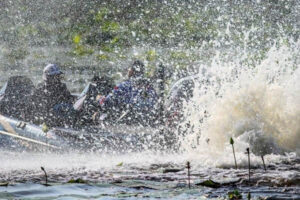More often than not, anglers tend to think of close combat and short casts when it comes to fishing heavy cover with frogs. While it’s certainly effective, there are times when keeping your distance can pay big dividends. When stealth is a necessity, long distance frog fishing can be hugely effective for big bass.
Scotch Blue pro Ray Scheide is certainly no stranger to heavy cover frog fishing. Whenever he finds himself in ultra-thick cover, he does a lot of damage by making long, pinpoint casts to avoid spooking suspicious bass.
It’s all about stealth
Bass are extremely wary creatures. Whether you’re skipping a jig under a dock, flipping a stick worm into a thick laydown or catching bass off beds, the importance of stealth in bass fishing cannot be overemphasized enough. With that in mind, Scheide makes a concerted effort to stay far away from his most productive waters.
“I use a Shimano Core 100MG7 Casting Reel when frog fishing and it allows me to make some insanely long casts,” Scheide said. “I like to position my boat on the edge of heavy cover, such as lily pads, and cast to the thick cover from cleaner water. The less crud my trolling motor is chopping up, the easier it is for me to catch big bass off-guard.”
Today’s trolling motors are designed to be very quiet, but noise is an inevitable factor when trudging through thick vegetation. Because sound travels so far in water, Scheide looks to avoid unwanted noise at all costs.
Scheide starts getting some bites on the Red River, so it’s time to break out the push pole.
“If you can hear your trolling motor banging against pad stems, imagine how loud it is to surrounding bass,” Scheide said. “You’re going to spook every one of them before your first cast. I also make sure to turn off my Lowrance units so there won’t be any pinging in the skinny water. I’ll leave on my Hydrowave usually, but I only have it on 20-percent volume at the most. ”
If getting his boat into the jungle is a necessity, Scheide uses a push pole instead of his trolling motor. To increase his efficiency, he’ll start by using his trolling motor until he hones in on a solid pattern.
“I’m not afraid to cover water in thick stuff with my trolling motor, but as soon as I get bit a few times, I pull it up and start push poling,” Scheide said.
Developing a long distance pattern
Whether it’s due to an algae bloom or poor oxygen content, Scheide continuously notices big bass moving toward shallow, backwater areas throughout the summer, which is the primary reason his long distance frogging technique is so effective. This held true for him during the 2013 Forrest Wood Cup on the Red River.
“Long distance frogging in heavy cover backwater areas changes each day,” Scheide said. “On the Red River, one day I’d get bit exclusively on the tall pads, while only getting bit on the flat pads the next day.”
Although the bass’ behavior can change daily, make no mistake—there will be giants lurking in these backwater areas. Finding them, however, requires keen observance.
“When I’m chunking a frog in these areas and searching for a pattern, I pay attention to every small detail,” Scheide said. “With a little practice, it can actually become quite obvious where your drains, ditches and depressions are. If the pads are sticking out of the way, you can bet it’s fairly shallow. If you can find an area with flat pads or open water, you’re in the right area. Drains, ditches and depressions are perfect places to target.”
Frog selection is important
While it may seem as if a pointed-nose topwater frog is better suited for Scheide’s technique, he actually prefers a SPRO Bronzeye Poppin’ Frog. There will be days the bass prefer the frog being popped as opposed to walked and vice versa, and the Bronzeye Poppin’ Frog gives Scheide the necessary versatility.
“This particular frog gives me the ability to cater my presentation to whatever the bass want on any given day,” Scheide said. “If I’m fishing in lowlight or windy conditions, I use brighter colors and if it’s calm and sunny, I like to use more natural color patterns.”
The fun part—getting the bass to the boat
So you finally make your way into a treacherous backwater and start generating a few bites. After your first blowup, you’ll quickly realize it’s not as easy as it looks on television. Scheide acknowledges the difficulty of getting big bass out of the cover and to the boat, but he’s developed a solid game plan to increase his hookup ratio.
“When a big bass blows up on my Bronzeye Poppin’ Frog on a long cast, It’s a ‘one, one thousand, whack’ count,” Scheide said. “There’s no better way to put it. You want to let them eat the frog, but you don’t want to wait long enough to let them get hung before your hookset. If they’re already around 2 or 3 pads when you lay the wood to them, you’ll lose direct contact with the frog, resulting in a less powerful hookset.”
Surprisingly, Scheide considers big bass easier to land on long casts. When a 6-pounder blows up in heavy vegetation, it creates a hole which makes it easier to dislodge the fish.
“Big ones wallow through the pads a lot and it’s easier to keep them on top of the water,” Scheide said. “When they get locked up on pad stems, I never pull as hard as I can. I’m not worried about my 65-pound Power Pro Spectra Braid breaking, but you can definitely pull the hook out of the fish. It’s best to keep tension on them and go get them with your trolling motor.”
Scheide also recommends an extremely stout rod for this application. He uses a 7-foot, 6-inch extra-heavy Denali Rosewood Series Casting Rod due to its balance and strength.
“You’ve got to set the hook as hard as you can, and the Rosewood has all the strength in the world, making huge hooksets easy,” Scheide said. “Not to mention, you can walk a frog all day with it and your arms will never hurt.”
If you’ve got an area on your home lake that looks fishy but the heavy vegetation has been scaring you away, break out the big sticks and try some long distance frog fishing. If you remain quiet and learn how to get through the crud, you’ll have outstanding results this summer.















